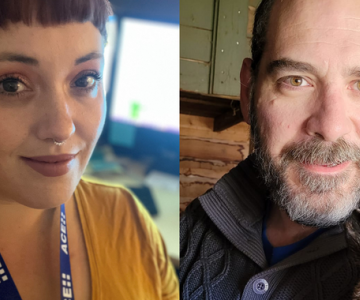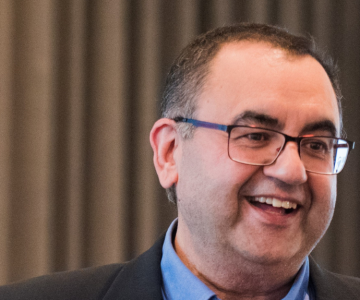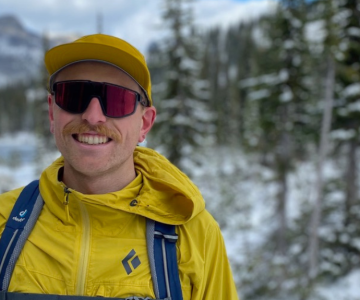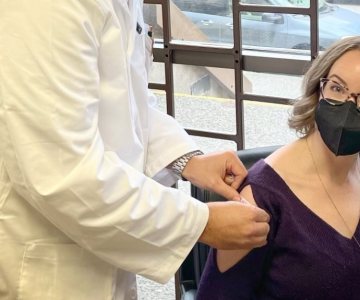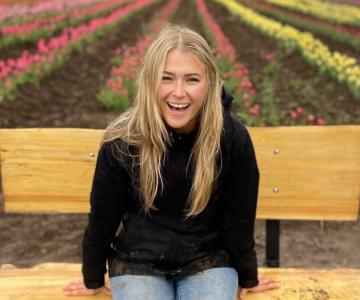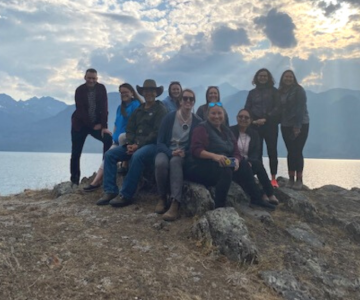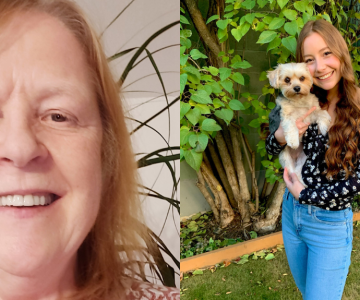Breadcrumb
Explore Stories
4 Minute Read
Community & Culture
Interior Health (IH) has a Digital Health (information technology) team committed to continuously adapting, responding and innovating to meet the needs of our population, while also supporting an efficient patient and provider experience.
The Digital Health team ensures resources and technology are used effectively across all geographic service areas. Meet two members of our dedicated digital health team who help make these new innovations possible.
2 Minute Read
Health & Wellness
As we get older, we’re more likely to have problems with our mouth and teeth, which may result in problems with chewing, pain, tooth loss, and partial or full dentures.
These issues may negatively impact one's ability to eat nutritious foods (fresh fruits and vegetables, meat, poultry, nuts, for example) and result in weight loss, muscle weakness, bone loss, malnutrition and/or increased frailty in older adults - adding up to an increased risk of falling and having a fall-related injury.
2 Minute Read
Community & Culture
We would like to begin this story by recognizing and acknowledging that we’re collectively gathered on the traditional, ancestral, and unceded territories of the seven Interior Region First Nations. This region is also home to 15 Chartered Métis Communities. It is with humility that we continue to strengthen our relationships with First Nation, Métis, and Inuit peoples across the Interior.
It’s a fitting way to begin a story whose subject is Dr. Harsh Hundal, a champion for inclusion and reconciliation within the health-care system since joining Interior Health in 2015.
Dr. Hundal serves as Executive Medical Director, Physician Engagement & Resource planning, and Chair of the Health Authority Medical Advisory Committee (HAMAC). Under his leadership, HAMAC became the first IH committee to regularly begin each meeting with a Traditional Territory Acknowledgment, which helped move our Traditional Territory Acknowledgment Policy forward.
After several years of strengthening engagement and reconciliation at Interior Health, Dr. Hundal is moving on from IH effective Nov. 4, 2022.
3 Minute Read
Community & Culture
Name: Greg Kilroy (he/him/his)Job Title: Medical Radiation TechnologistYears of Service: 5Worksite: Kootenay Boundary Regional HospitalCommunity: TrailAncestral Territory: Ktunaxa Nation and Okanagan NationFavourite Quote / Advice to live by: Wake up, love life and put your best foot forward.
As a medical radiation technologist, Greg Kilroy’s goal is to help make patients’ hospital visits as enjoyable as possible. Even though he works every day in the operating room, emergency department and diagnostic imaging, Greg often reminds himself that patients don’t feel as comfortable in these environments as he does.
“My goal is ensure all patients feel safe and cared for, and to provide the best diagnostic images possible,” he said.
3 Minute Read
Community & Culture
Name: Kerry Carlson (she/her/hers)Job Title: Physiotherapist (Community Care)Years of Service: 30Worksite: Vernon Jubilee HospitalCommunity: VernonAncestral Territory: Syilx OkanaganFavourite Quote / Advice to live by: “Everyone you meet is fighting a battle you know nothing about. Be kind. Always!” — Robin Williams
Kerry Carlson was born and raised in the small community of Morinville, Alta. She graduated from the UBC School of Physical Therapy in 1992 after an initial career in medical research. Kerry traded test tubes for people, and started a new physiotherapy career at Queen Victoria Hospital in the lovely mountain town of Revelstoke.
It was in October 1992, that Kerry first walked into Vernon Jubilee Hospital and was hired as a casual physiotherapist.
4 Minute Read
Health & Wellness
Thinking about getting a flu shot this year? We asked Dr. Carol Fenton, a medical health officer with Interior Health, to share the questions she gets most often about influenza and the flu shot.
Make an informed decision and keep yourself and your family safe this winter.
What is influenza?
Influenza, sometimes called “the flu,” is a respiratory infection. It is like a cold but much worse. It spreads through droplets and from contaminated surfaces, especially in the winter.
Why do we see more colds and flu in the winter?
We do normally see more respiratory infections, like colds or flu, in the winter. This may be because we spend more time with others indoors, or it may be because these viruses can spread easier and survive longer when the air is less humid. Most likely it’s a combination of both.
How do I tell if I have a cold or if I have influenza?
Typically, with a cold, people feel unwell, they have a congested and runny nose, and they may have a sore throat or a cough. Fever is very rare with a cold.
Influenza is typically more severe, with fever, cough, muscle aches, and fatigue. For some people, this is as bad as it gets; for others, it can be so severe that they need to be hospitalized or they can die from it.
Why should I care about influenza this year?
In Canada, thousands of people are hospitalized and die from the influenza infection or from secondary infections like pneumonia during seasons when influenza is circulating through the population.
Last year, many public health measures to stop the spread of COVID-19 also worked really well to stop the spread of the influenza virus. This year, the restrictions are different so we need to make sure we continue to prevent influenza as well.
Who should get a flu shot?
The people who are at the most danger from influenza infections are young children and infants, the elderly, people who have lung conditions like asthma, people who have neurologic conditions, people who have blood conditions, people with diabetes, heart disease, kidney disease, liver disease, people who are on certain medications, and people who are immune compromised. These people need influenza vaccine to give their immune systems the ability to generate protection against the influenza virus. However, some of these conditions and medications may affect their body’s ability to generate really good protection from the vaccine.
The other people who need influenza vaccine are all those who come into contact with anybody who is at risk. If you know of or might interact with anyone in the previous group in the winter season, you also need an influenza vaccine to prevent spreading the virus to them. So, unless you don’t leave your house, you also need to be vaccinated for influenza.
Do I need both the COVID-19 vaccine and a flu shot?
Anyone who has not had a COVID vaccination in the last six months is no longer up to date so it’s time to get their fall booster. With the potential for both the influenza and COVID-19 viruses circulating this winter season, there is a chance you could be infected with both at the same time, which would be bad. A better choice would be to prevent both!
Who can get a free flu shot?
Anyone over the age of six months is eligible for free influenza vaccination. Get up-to-date information on the influenza vaccine by visiting the provincial Influenza vaccine (flu vaccine) page.
New in 2022, people will be able to book their influenza vaccine online through the provincial Get Vaccinated system. Booking through the Get Vaccinated system is the most efficient way to access an influenza vaccine
Learn more about getting an influenza vaccine this year
If I get my COVID-19 vaccine, do I need to wait a while before I get my flu vaccine?
No, there is no waiting period after getting your COVID-19 vaccine before getting your influenza vaccine, and vice versa. You could get one in each arm!
Besides getting both the COVID-19 and influenza vaccines, what else can my family do to keep healthy this season?
Now that respiratory viruses are circulating again, we need to redouble our efforts to wash our hands correctly and often, and disinfect high touch surfaces.
The best thing we can do is support people to stay home if they are sick. It’s still a good idea to wear a mask properly over your nose and mouth when you are in public indoor spaces.
2 Minute Read
Community & Culture
Name: Renee Faubert (she/her/hers)Job Title: Clinical Respiratory Educator (Registered Respiratory Therapist, or RRT)Years of Service: 5.5Worksite: Kelowna General HospitalCommunity: KelownaAncestral Territory: Syilx OkanaganFavourite Quote / Advice to live by: It is what it is.
Renee Faubert’s goal as Kelowna General Hospital’s (KGH’s) respiratory therapy (RT) educator is to ensure Interior Health delivers the best respiratory care to all patients, but especially pediatric patients. Registered respiratory therapists (RRTs) are certified medical professionals who treat problems with a patient's lungs or breathing. RRTs work closely with doctors to diagnose and monitor a patient's condition.
Renee keeps her colleagues up to date with the latest medical evidence, shows them how to use the latest respiratory equipment and serves as a resource in complex cases.
“I’m involved with respiratory therapy education related to ventilation in the ICU, tracheostomy education on wards, and I’m available to all KGH staff who have respiratory-related questions,” says Renee.
Most of her career has been spent in pediatrics and neonates (newborns). She has been involved with many pediatric regional policies, educational opportunities and presentations. Renee is a Pediatric Advanced Life Support and Basic Life Support instructor, and takes pride in sharing her respiratory knowledge of pediatrics to other specialties.
4 Minute Read
Community & Culture
How do health and wellness leaders gain perspective on the health challenges faced by rural and remote communities? They make time to visit with the people who live there, listen to their stories, and build meaningful relationships.
Recently, the Xeni Gwet’in First Nation hosted a meeting of the Partnership Accord Leadership Table (PALT), a regional table comprised of the seven Interior Region First Nation Executives, Interior Health board and senior executive team members, and First Nation Health Authority (FNHA) executives. PALT meets quarterly to strategize and make decisions around the health and wellness needs of First Nations peoples.
The meeting marked the first time that PALT met outside of a large urban centre, reflecting a decision by representatives to hold every second meeting in a First Nation community within the Interior region. Given that half of Aboriginal populations live in rural and remote communities across the Interior, this decision provides valuable first-hand insight into the unique challenges they experience.
Salmon wash ashore at Chilko Lake.Xeni Gwet’in is one of six communities within the Tsilhqot’in Nation, located approximately 200 kilometres west of Williams Lake. The community is nestled in a remote valley surrounded by coastal mountains. Glacier-fed lakes and rivers provide important salmon grounds. Approximately 150 Tsilhqot'in deni (people) live within the territory; an additional 250 community members live across colonial Canada.
One challenge faced by rural and remote communities such as Xeni Gwet’in is the logistics of travel. Located three hours by car from Williams Lake and eight hours from Kelowna, the final 100 kilometres approach is gravel road. Car issues such as blowouts are not uncommon. With no repair shops nearby, both collaboration and self-sufficiency are crucial. Health-care service delivery in rural and remote areas requires innovative approaches, such as an increased reliance on digital health services to meet these challenges.
Several members of the Interior Health delegation arrived at Xeni Gwet’in with flat tires and were grateful for help provided by community members to patch them up. Dr. Doug Cochrane, the IH Board Chair, and Addie Pryce, Vice President for Aboriginal Partnerships, (pictured above) were also temporarily sidelined on their return trip with a flat.Another challenge facing many rural, remote and Aboriginal communities is water quality. Unsafe drinking water has serious, long-ranging health effects. At the time of the PALT meeting, only half of the community had access to clean, drinkable water. A major project is underway in the community to ensure that drinking water is available to all.
The opportunity to travel into Xeni Gwet’in provided valuable learning experiences, including a deeper understanding of the challenges faced by many First Nations in caring for their people, one of them being equitable access to health care.
3 Minute Read
Community & Culture
Health care assistants (HCAs) make a tremendous difference in our lives. HCAs may have many different job titles, including:
Community Health Worker
Residential Care Aide
Home Support Worker
Long-Term Care Aide
Home Health Aide
Continuing Care Assistant
Personal Care Aide
The one thing all HCAs have in common is that they provide frontline personal care and assistance services to vulnerable patients, clients and residents.
Meet two of our HCAs at Interior Health.
-
Load More
Showing 288 of 677
STAY CONNECTED
Receive news and alert posts, and Stories@IH blog posts, right to your inbox!

